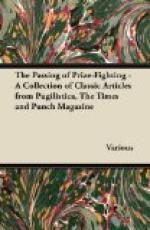The opening lecture introduces the new man to his companions, and he is easily distinguished at that annual gathering of pupils, practitioners, professors, and especially old hospital governors, who do a good deal in the gaiter-line, and applaud the lecturer with their umbrellas, as they sit in the front row. The new man is known by his clothes, which incline to the prevalent fashion of the rural districts he has quitted; and he evinces an affection for cloth-boots, or short Wellingtons with double soles, and toes shaped like a toad’s mouth, a propensity which sometimes continues throughout the career of his pupilage. He likewise takes off his hat when he enters the dissecting-room, and thinks that beautiful design is shown in the mechanism and structure of the human body—an idea which gets knocked out of him at the end of the season, when he looks upon the distribution of the nerves as “a blessed bore to get up, and no use to him after he has passed.” But at first he perpetually carries a
[Illustration: “DUBLIN DISSECTOR”]
under his arm; and whether he is engaged upon a subject or no, delights to keep on his black apron, pockets, and sleeves (like a barber dipped in a blacking-bottle), the making of which his sisters have probably superintended in the country, and which he thinks endows him with an air of industry and importance.
The new man, at first, is not a great advocate for beer; but this dislike may possibly arise from his having been compelled to stand two pots upon the occasion of his first dissection. After a time, however, he gives way to the indulgence, having received the solemn assurances of his companions that it is absolutely necessary to preserve his health, and keep him from getting the collywobbles in his pandenoodles—a description of which obstinate disease he is told may be found in “Dr. Copland’s Medical Dictionary,” and “Gregory’s Practice of Physic,” but as to under what head the informant is uncertain.
The first purchase that a new man makes in London is a gigantic note-book, a dozen steel pens on a card, and a screw inkstand. Furnished with these valuable adjuncts to study, he puts down every thing he hears during the day, both in the theatre of the school and the wards of the hospital, besides many diverting diagrams and anecdotes which his fellow-students insert for him, until at night he has a confused dream that the air-pump in the laboratory is giving a party, at which various scalpels, bits of gums, wax models, tourniquets, and foetal skulls, are assisting as guests—an eccentric and philosophical vision, worthy of the brain from which it emanates. But the new man is, from his very nature, a visionary. His breast swells with pride at the introductory lecture, when he hears the professor descant upon the noble science he and his companions have embarked upon; the rich reward of watching the gradual progress of a suffering fellow-creature to convalescence, and the insignificance of worldly




